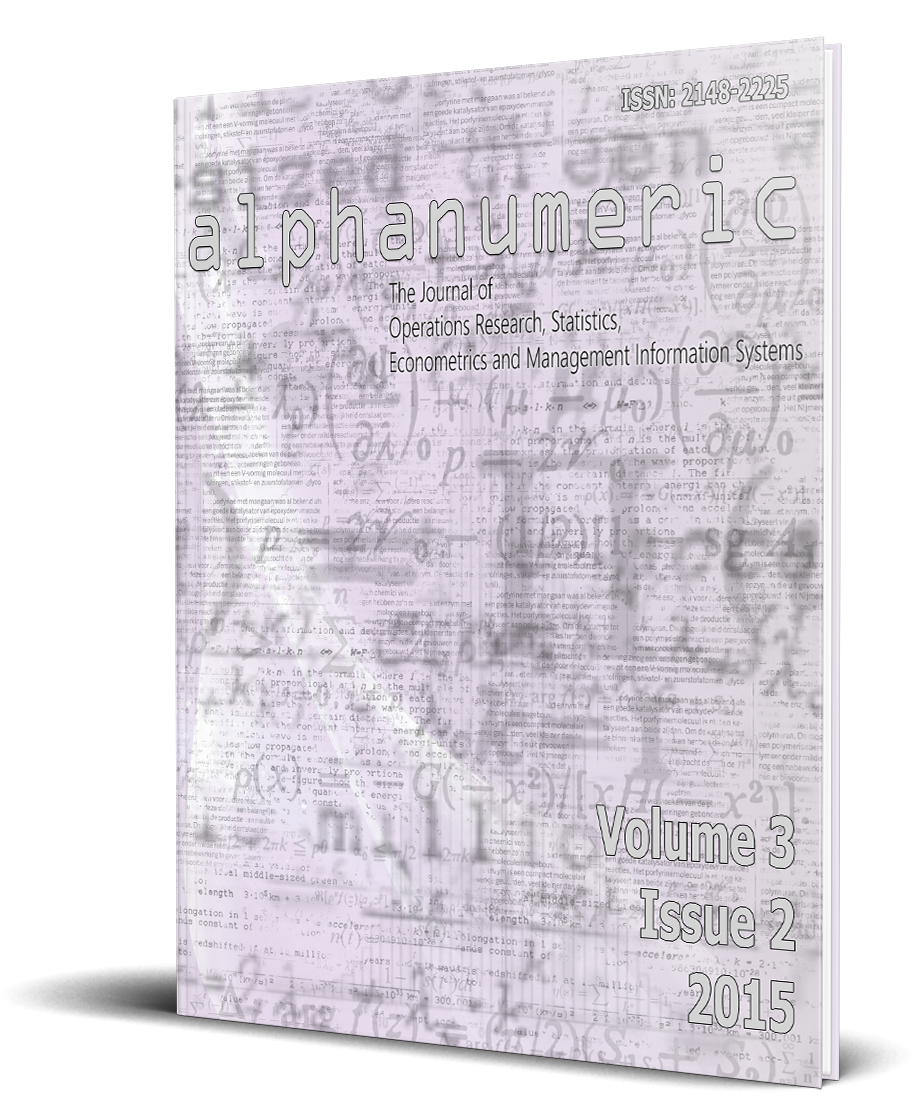
alphanumeric journal
The Journal of Operations Research, Statistics, Econometrics and Management Information Systems
Forecasting Turkish Informatics Valley via Computerised Argument Delphi Technique
Abstract
The aim of this study is an actual foresight analysis of Information Valley in Turkey and its social analysis through scientific methodologies and interpretation of its outcomes. Computerized Argument Delphi method has been utilized in order to collect the information from social networks with crowd sourcing approach. The method also supplies the dialectic discussion on the arguments of the contributors. Also the outcomes achieved from the computerized Argument Delphi has been aggregated and evaluation within the technique. This paper covers the details of the methodology, demography of the contributors, outcomes and the meaning of outcomes from the job clustering perspective.
Keywords: Crowd Sourcing, Delphi Technique, Information Valley, Job Clusters, Management Information Systems, Qualitative Forecasting Methods, Social Networks
Jel Classification: C53
Türkiye Bilişim Vadisinin Bilgisayarlı Argüman Delfi Yöntemi İle Öngörülmesi
Öz
Bu çalışmanın amacı, son yıllarda gündeme gelen Türkiye’nin “Bilişim Vadisi” projesinin toplumsal öngörü analizini bilimsel yöntemlerle yaparak çıkan sonuçların yorumlanmasıdır. Konu hakkında kitle kaynak kullanılarak sosyal ağlar üzerinde konuya ilgi duyan kişilerin diyalektik tartışmalarına imkan veren bilgisayarlı argüman Delfi yöntemi kullanılmış ve elde edilen sonuçlar yine bu yöntemle birleştirilerek değerlendirilmiştir. Makale kapsamında, kullanılan metodun detayları, ulaşılan kişiler ve demografik yapısı, elde edilen bulgular ve bu bulguların iş kümeleri açısından anlamı açıklanacaktır.
Anahtar Kelimeler: Bilişim Vadisi, Delphi Tekniği, Kalitatif Tahmin Yöntemleri, Kitle Kaynak, Sosyal Ağlar, Yönetim Bilişim Sistemleri, İş Kümeleri
Suggested citation
(). Türkiye Bilişim Vadisinin Bilgisayarlı Argüman Delfi Yöntemi İle Öngörülmesi. Alphanumeric Journal, 3(2), 113-120. http://dx.doi.org/10.17093/aj.2015.3.2.5000144683
References
- Acemoglu, D. (1997). Training and Innovation in an Imperfect Labour Market. Review of Economic Studies , 64 (3), 445-464.
- Custer, R. L., Scarcella, J. A., & Stewart, B. R. (1999). The Modified Delphi Technique - A Rotational Modification. Journal of Vocational and Technical Education , 15 (2).
- Dwyer, T., Lee, B., Fisher, D., & Quinn, K. (2009). A Comparison of User-Generated and Automatic Graph Layouts. Visualization and Computer Graphics, IEEE Transactions on , 15 (6), 961 - 968.
- Fallick, B., Fleischman, C. A., & Rebitzer, J. B. (2006). Job-Hopping in Silicon Valley: Some Evidence Concerning the Microfoundations of a High-Technology Cluster. The Review of Economics and Statistics , 88 (3), 472-481.
- Neuman, W. L. (2009). Social Research Methods: Quantitative and Qualitative Approaches (7. Baskı). Pearson.
- Onwuegbuzie, A. J., & Collins, K. M. (2007). A Typology of Mixed Methods Sampling Designs in Social Science Research. The Qualitative Report , 12 (2), 281-316.
- Peters, E., & Hood, N. (2000). Implementing the Cluster Approach: Some Lessons from the Scottish Experience. International Studies of Management & Organization , 30 (2), 68-92.
- Porter, M. E. (2000). Competition, and Economic Development: Local Clusters in a Global Economy. Economic Development Quarterly , 14 (1), 15-20.
- Roberts, D. M., & Bilderback, E. W. (1980). Reliability and Validity of a Statistics Attitude Survey. Educational and Psychological Measurement , 40 (1), 235-238.
- Roland Wiese, Markus Eiglsperger, & Michael Kaufmann. (2004). yFiles — Visualization and Automatic Layout of Graphs. Chapter Graph Drawing Software, Part of the series Mathematics and Visualization , 173 - 199.
- Roten, F. C., & Roten, Y. d. (2013). Statistics in science and in society: From a state-of-the-art to a new research agenda. Public Understanding of Science , 22 (7), 768-784.
- Seidman, I. (2005). Interviewing as Qualitative Research: A Guide for Researchers in Education and the Social Sciences (Cilt 3). Teachers College Press;.
- Seker, S. E. (2014). Bilgi Yönetimi (Knowledge Management). YBS Ansiklopedi , 1, 8 - 14.
- Seker, S. E. (2015). Computerized Argument Delphi Technique. IEEE Access , 3, 368-380.
- Seker, S. E. (2015). Kitle Kaynak (Crowd Sourcing). YBS Ansiklopedi , 2, 6-11.
- Seker, S. E. (2015). Metin Madenciliği (Text Mining). YBS Ansiklopedi , 2 (3), 30-32.
- Seker, S. E. (2015). Motivasyon Teorisi (Motivation Theory). YBS Ansiklopedi , 2, 22 - 27.
- Seker, S. E. (2015). Temporal logic extension for self referring, non-existence, multiple recurrence and anterior past events. Turkish Journal of Electirical Engineering and Computer Sciences , 23 (1), 212-230.
- Seker, S. E., & Al-Naami, K. (2013). Sentimental analysis on Turkish blogs via ensemble classifier. roc. the 2013 International Conference on Data Mining, (s. 10 - 16).
- Seker, S. E., & Eryarsoy, E. (2015). Generating Digital Reputation Index: A Case Study. Procedia-Social and Behavioral Sciences , 195, 1074-1080.
- Seker, S. E., Altun, O., Ayan, U., & Mert, C. (2014). A Novel String Distance Function Based on Most Frequent K Characters. International Journal of Machine Learning and Computation (IJMLC) , 4 (2), 177-183.
2015.03.02.MIS.02
alphanumeric journal
Pages 113-120
Received: Oct. 4, 2015
Accepted: Dec. 25, 2015
Published: Dec. 31, 2015
2015 Emen, E., Salman, E., Sekendur, G., Şeker, ŞE.
This is an Open Access article, licensed under Creative Commons Attribution-NonCommercial 4.0 International License.

scan QR code to access this article from your mobile device
Contact Us
Faculty of Transportation and Logistics, Istanbul University
Beyazit
Campus 34452 Fatih/Istanbul/Türkiye
Bahadır Fatih Yıldırım, Ph.D.
editor@alphanumericjournal.com
+ 90
(212) 440 00 00 - 13219
alphanumeric journal
alphanumeric journal has been publishing as "International Peer-Reviewed Journal" every six months since 2013. alphanumeric serves as a vehicle for researchers and practitioners in the field of quantitative methods, and is enabling a process of sharing in all fields related to the operations research, statistics, econometrics and management informations systems in order to enhance the quality on a globe scale.

